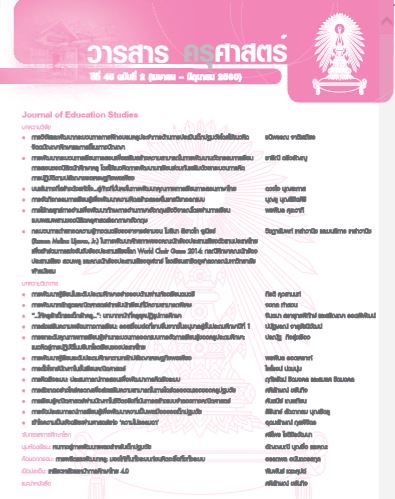การเรียนรู้คณิตศาสตร์ผ่านปัญหาในชีวิตจริงที่เน้นการสร้างแบบจำลองทางคณิตศาสตร์
คำสำคัญ:
การสร้างแบบจำลองทางคณิตศาสตร์, ปัญหาคณิตศาสตร์, ปัญหาในชีวิตจริง, ตัวแบบเชิงคณิตศาสตร์, MATHEMATICAL MODELING, MATHEMATICAL PROBLEM, REAL-WORLD PROBLEM, MATHEMATICAL MODELบทคัดย่อ
ทักษะการแก้ปัญหาทางคณิตศาสตร์เป็นเป้าหมายสำคัญของการจัดการเรียนรู้คณิตศาสตร์ ในขณะที่ทักษะการเชื่อมโยงความรู้ทางคณิตศาสตร์จะช่วยให้ผู้เรียนเห็นความเชื่อมโยงของความรู้คณิตศาสตร์กับชีวิตจริงและเรียนรู้คณิตศาสตร์อย่างมีความหมาย การพัฒนาทักษะทั้งสองให้เกิดขึ้นกับผู้เรียนจึงเป็นสิ่งสำคัญ แนวทางหนึ่งที่สามารถช่วยพัฒนา คือ การสร้างแบบจำลองทางคณิตศาสตร์ ซึ่งเป็นกระบวนการในการแก้ปัญหาที่สามารถนำไปใช้ในกิจกรรมการเรียนรู้คณิตศาสตร์ เน้นให้ผู้เรียนมีส่วนร่วมในกิจกรรมการเรียนรู้ผ่านการแก้ปัญหาในชีวิตจริงโดยใช้ความรู้และวิธีการทางคณิตศาสตร์ เริ่มจากการให้ผู้เรียนเผชิญปัญหาที่เป็นปัญหาในชีวิตจริงที่ผู้เรียนต้องใช้การสร้างแบบจำลองทางคณิตศาสตร์เป็นกระบวนการคิดเพื่อแก้ปัญหา โดยผู้เรียนต้องมีการแปลงสถานการณ์ปัญหาในชีวิตจริง ให้เป็นสถานการณ์ปัญหาทางคณิตศาสตร์ สร้างตัวแบบเชิงคณิตศาสตร์ ดำเนินการแก้ปัญหาและหาคำตอบเชิงคณิตศาสตร์ และนำคำตอบที่ได้ไปแปลงเป็นคำตอบปัญหาในชีวิตจริง ทั้งนี้ การสร้างแบบจำลองทางคณิตศาสตร์ เป็นแนวทางที่สามารถนำไปใช้ได้กับผู้เรียนในทุกระดับชั้นโดยเฉพาะอย่างยิ่งระดับประถมศึกษาและระดับมัธยมศึกษา นักการศึกษาคณิตศาสตร์ได้ออกแบบขั้นตอนหรือวงจรของการสร้างแบบจำลองทางคณิตศาสตร์ไว้อย่างหลากหลาย โดยในบทความนี้จะนำเสนอวงจรของการสร้างแบบจำลองทางคณิตศาสตร์บางวงจร พร้อมยกตัวอย่างประกอบ โดยตัวอย่างปัญหาในชีวิตจริงที่นำเสนอ เป็นปัญหาที่ใช้ความรู้ทางคณิตศาสตร์ระดับมัธยมศึกษาในการแก้ปัญหา เพื่อจะเป็นประโยชน์ต่อครูผู้สอนที่จะนำไปปรับใช้ในการจัดกิจกรรมการเรียนรู้คณิตศาสตร์ให้เหมาะสมกับบริบทไทย
The mathematical problem-solving skill is the major goal of teaching and learning mathematics. The mathematical connection skill is useful for students to bring out the connection between mathematical knowledge and the real-world context, and to contribute meaningful learning in mathematics. One approach to enhance both mathematical skills is called mathematical modeling. This is a problem solving process that can be implied in mathematics learning activities emphasizing students’ engagement through solving real-world problems by mathematical knowledge and procedures. Starting with, students are aroused to solve real-world problems by using mathematical modeling. In the beginning of the solution process, students need to understand and simplify a real-world problem, and then transfer it to be a mathematical problem. After that, the student solves the mathematical problem by formulating a mathematical model, applying mathematical procedure, finding the mathematical result, and interpreting the mathematical result into a real result, respectively. Mathematical modeling is an approach that can be applied to all levels of education, especially at the elementary and secondary levels. Many mathematical educators suggest many modeling processes or modeling cycles to correspond with mathematical modeling. In this article, some of these modeling cycles are described with or without the examples of modeling problems. The background to mathematical knowledge to solve the examples of modeling problems presented in this article are based on those of secondary level. The body of knowledge of this article is shown in order to support mathematics teachers, who utilize it for designing mathematics learning activities in the Thai context.




